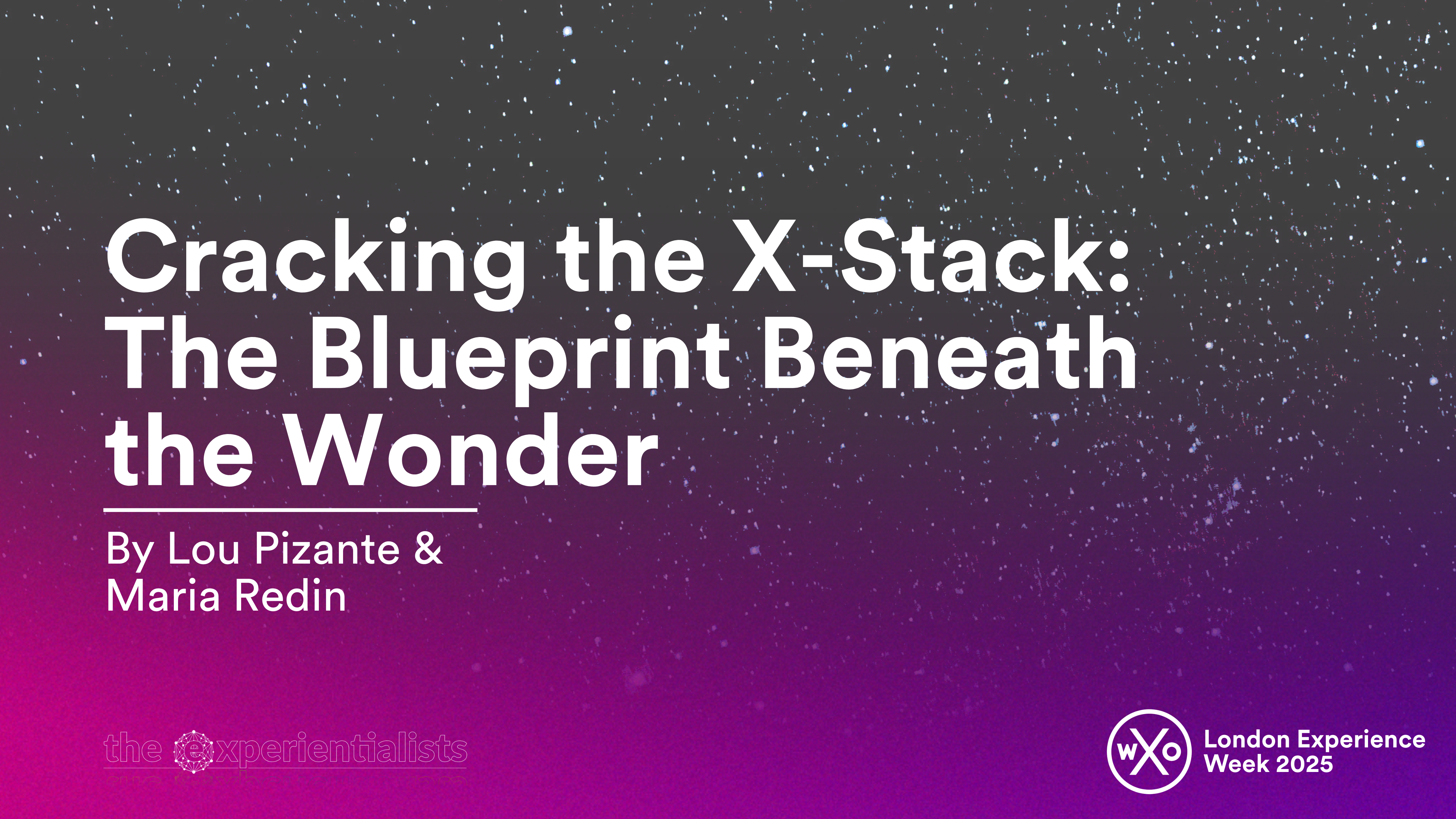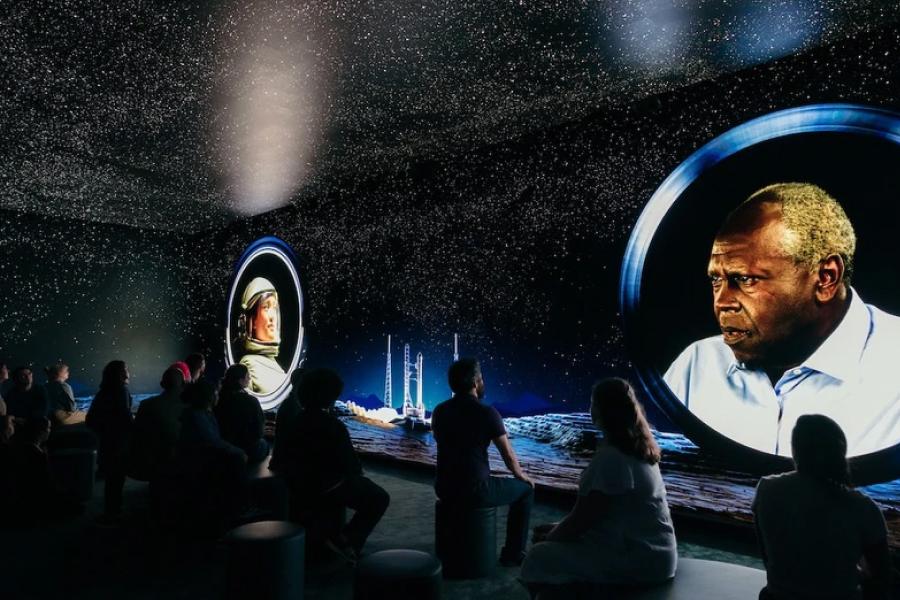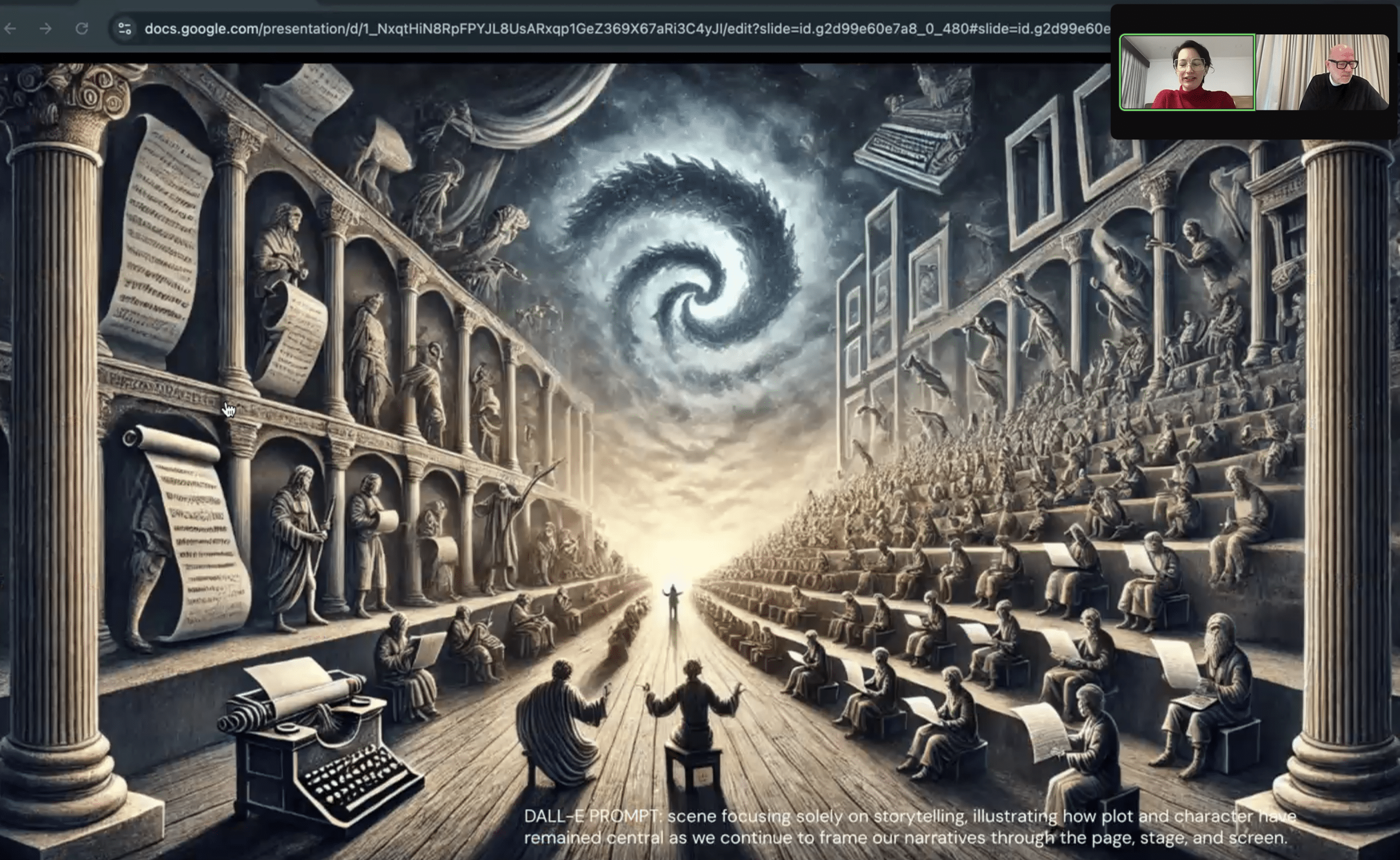How do you turn an experience into an actual business without losing the magic (or your mind)? The X-Stack is our answer—and this article is your first look. We’ll be digging into it live at the World Experience Summit during London Experience Week 2025, with a panel and a full track of sessions curated by the WXO and built to help you go from first brainstorm to sustainable, scalable wonder. By Lou Pizante & Maria Redin
It always starts the same way. A sketch on a napkin. A “what if…” text thread that spirals into a pitch deck, a prototype, and a domain name you definitely should’ve run by someone sober. One minute, you’re envisioning a transcendent world of light, sound, and emotional catharsis. Next, you’re explaining to the fire marshal why your “bioluminescent regret tunnel” technically counts as an egress path.
We’ve been there. Creatives, operators, landlords, capital, marketing partners—we’ve played all the roles. We’ve seen the magic. And we’ve seen it implode under a lease term, a broken HVAC unit, and a last-minute call from an investor who wants to swap the finale for a fire-breathing NFT llama.
What we’re about to share wasn’t born from one project. It came from years of building things that didn’t show up on org charts, weren’t in any business school syllabus, couldn’t be found in the library, and—somehow—even Reddit had nothing useful to say. It came from watching, firsthand, incredible ideas launch with vision and heart—and no fire suppression plan. From sitting in too many meetings where someone said, “We’ll figure it out later,” and then didn’t.
Eventually, we realized we weren’t just making mistakes—we were collecting them. Some, we made twice (or more). Others, we avoided thanks to kind, battle-scarred mentors who warned us first.
What we’ve assembled here isn’t theory. It’s what we learned in practice—through poorly understood lease clauses, fragile cash flows, staff-to-guest ratios that worked on spreadsheets, and signage font size regulations we now know by heart and wish we didn’t.
We distilled that all into the X-Stack.
Not a metaphor. Not a mood board. A layered, real-world structure for turning location-based experiential (LBX) concepts into actual businesses. The kind of structure that holds up when the guest count spikes, the fuse box shorts, and your creative lead demands a glitter tunnel that whispers encouragement in six languages.
The X-Stack has five layers:
- Capital
- Real Estate
- Creative
- Operations
- Marketing
Each layer has its own strange physics, seductive delusions, and financial bear traps. Skip one, and you’ll spend the next two years trying to turn non-revenue-generating responsive beanbags that scream compliments when kicked into something financially viable. But build them all with intention, and you’ve got something that lasts. Something that scales. Something that still feels like magic on a rainy Tuesday with a cranky birthday group.
So take a breath. Close the spreadsheet (for now). And for the love of all things circuit-based, double-check your floor load before signing off on the ceiling hammock lounge made of ethically sourced bungee cords and poor judgment.
Let’s crack the X-Stack.

Up first is Capital.
Look—we know, we really know. You didn’t get into experiential to talk about preferred equity or amortization schedules. You got into it to make awe, to build worlds, to transport people into alternate realities where they can cry, dance, heal, scream, maybe kiss a robot (and hopefully get a kiss back).
But before the doors open, before the scenic is installed, before the safety inspector fails you for the third time because your portal to the astral plane doesn’t have handrails—you need funding. And that funding will shape what you can build, how fast you can build it, who’s in charge, and whether you end up sleeping in your own loading dock wondering where the money went.
What if your experience is a non-profit funded by grants? High five! You still need to know this stuff. That kind of money might not come with equity terms, but it does come with expectations: impact, integrity, and often a very specific final report template—and that’s why, in our framework, it still counts as capital.
Let’s be clear: capital doesn’t kill creativity—it sets it free. It’s the bridge between your imagination and the part where guests actually walk through the door, wondering why the walls are whispering and the floor smells like citrus and longing.
If you ignore this stuff, you’re not building a business. You’re building a very elaborate and emotionally resonant cash flow bonfire. Without capital, your mind-blowing multisensory mythos is just a well-formatted hallucination in Google Slides. With it, it’s something people can experience, tweet about, and maybe even pay for.
Here’s the good news: this doesn’t have to suck. We’ve been through it. We’ve made the mistakes. And we’re going to walk you through the essentials without turning this into a finance seminar.
So take a breath. We’re going in. Bravely. Cautiously. Armed with a calculator and just enough hope to survive due diligence.
Let’s start with the basics: What the heck even is Capital?
Capital is the first and most fundamental layer of the X-Stack. It’s also the one most founders would rather talk around than talk about. But you cannot build a real-world experience without real-world money. And how you raise it determines what you’re allowed to build, when, and with how much control.
First, know the difference between CapEx and OpEx. If this feels obvious, skip ahead. If not: CapEx is what you spend to build the thing—construction, scenic, AV, design, tech, bathrooms. OpEx is what you spend to keep it alive—rent, salaries, toilet paper, insurance. One is a mountain. The other is a treadmill. Investors want to know which they’re funding and when they’ll get their money back.
And yes, they do expect a return. Unless everyone is cool with you building an immersive feelings garden in an untrodden desert. Usually, investors want “cash-on-cash” returns over 33% (think CapEx), and EBITDA margins in the high 20s and hopefully cresting 30% (think OpEx). That means you can’t just sell out your soft launch and call it a win. You need to sustain. You need to design for scale. You need to have enough cash left after payroll, rent, Adwords, repairs, and staff birthday cupcakes to actually return something to the people who made the whole thing possible.
That means understanding unit economics. What’s your revenue per guest per minute per square foot? What’s your cost per experience cycle? How many birthday parties, memberships, or merch sales do you need to cover your monthly nut? If you can’t answer that, you’re not running a business. You’re running a beautiful experiment.
And then there’s dilution. Everyone loves talking about creative control—until they’ve given up 42% of the company before the first coat of paint dries. The further you go without understanding your cap table, the more likely you are to find yourself pitching your own idea to someone who technically owns more of it than you do.
Before you sign the check, ask yourself the questions that actually determine your future. Is this the right type of capital for what I’m building—equity, debt, or something even stranger? What does my cash runway really look like, in numbers, not hopeful energy? What level of control am I giving up—and to whom? And perhaps most critically, can I clearly explain how and when my investors will get their money back, without using the words “if all goes well” or “vibes”?
This isn’t about turning your dream into a spreadsheet. It’s about making sure the math doesn’t murder the magic.
Oh! And if you don’t know what any of the words in this section mean, good news: you just figured out a position you need to hire for.

Capital enables the dream. Real estate proves it’s real.
You can have the most visionary concept in the multiverse, but until it has a roof, a floor, and a fire exit, it’s just a poetic Canva. Real estate is what takes the ephemeral and makes it physical. It’s what turns imagination into occupancy. And in LBX, the building isn’t just a venue—it’s a character in the world you’re creating.
Unlike most industries, where rent is just overhead and square footage is interchangeable, in LBX the space is part of the story. Guests don’t just visit your show—they visit your venue. They take photos of it. They judge it. They get lost in it. Your site choice shapes every emotional and operational moment that follows. This isn’t just where the experience happens. It’s part of what makes it feel real.
So yes, real estate matters. But don’t confuse emotion with logic. Fall in love with the role the space plays in your world—not the building itself. A raw loft with beautiful patina might look perfect on Pinterest, but if the HVAC doesn’t work and the power supply can’t handle an animatronic jellyfish that dispenses lavender mist and plot twists, your guests will experience something—but it won’t be what you intended.
Real estate defines your constraints. Ceiling heights, egress paths, column spacing, restroom count, load-bearing capacity—these aren’t details, they’re design prompts. Your operations, your creative, and your guest flow all get filtered through the physical limits of the space you choose. If you ignore that, you’ll be improvising logistics inside a box that doesn’t want to hold them.
But here’s the upside: your building is part of the experience—and part of the marketing. The outside sets expectations. The inside is the world. Guests don’t just see it—they enter it. Every wall, hallway, and sightline shapes what they feel.
In LBX, real estate is story architecture. And when it works, it becomes its own form of advertising.
And please just don’t design yourself into a literal corner. If you ever want to scale, avoid layouts that only work inside a sacred trapezoid with one working drain and a mezzanine shaped like a mistake. Your first venue is a world—but it’s also a prototype. Build like you’ll need to copy it.
Of course, your beautiful prototype still needs one thing: legal permission to exist.
Don’t assume your landlord understands what you’re building. Most are used to retail, restaurants, maybe a yoga studio—not a feelings-forward dream loop with motion tracking and 900 amps. You’ll need to explain it in their language: revenue per square feet, security deposit, additional insured. If they can’t make sense of the model, you’re not getting the deal you want—if you get one at all.
Look, the lease is not a formality—it’s a business deal. And if the deal doesn’t match your business model, you’ve got two options: revise the lease, or revise the model. Signing a fixed rent term lease for a seasonal business is not brave—it’s mathematically suicidal. On the flip side, negotiating a revenue share in a prime retail corridor might get you killed by your own foot traffic. The terms matter. The structure matters. The lease will determine what you can survive.
And–for the love of sentient disco balls everywhere—don’t forget compliance: occupancy, permits, accessibility, safety, use. These aren’t bureaucratic chores—they’re what determine whether your experience opens on time or dies in a black hole of paperwork and missed inspections. Building and fire officials don’t care about your story arc. They care about whether your enchanted tree canopy blocks an exit, whether your dream vortex is technically a trip hazard, and whether your asthma-forward haze machine is slowly turning the venue into a low-visibility death box.
Which means you need the right team—architects and engineers who understand experiential formats, not just cafes, condos, and passive-aggressive water features. If they can’t translate “multi-sensory dream portal” into a code-compliant drawing set with proper egress and load calculations, you’re not opening. You’re explaining your vision for the third time to a plan checker named Carl who thinks “interactive forest of emotion” is grounds for structural concern.
And how does that conversation end? You’re not launching. You’re printing revised elevations at 3AM and googling “what is non-combustible joy?”
So, before you fall in love with exposed brick and ambient expectations, pause and ask: is this space going to elevate the guest experience—or slowly strangle it with invisible constraints? Can the infrastructure actually support what you’re trying to pull off, or are you about to drop half your budget making a 1920s bakery compatible with synchronized projection mapping and three bathrooms? Is the deal structured to support your business model—or sabotage it by year two with cheerful indifference? Is this site a viable prototype you could replicate—or just a seductive nightmare disguised as a daydream that you’ll never be able to scale? And can you actually afford to build what the experience demands—or are you about to spend eighteen months “reverse-engineering” your concept around a building that doesn’t believe in plumbing?

This is why most of us showed up. World-building. Sensory design. Narrative beats. Maybe some tasteful slime. Creative is the soul of the experience. But in experiential, even souls have a cost per square foot.
Here’s the truth: your creative choices aren’t just aesthetic. They’re structural. Every decision—story, format, duration, interactivity, cast size, ceiling height—has ripple effects through your CapEx, OpEx, throughput, and staffing model. Creative ambition without creative math is how you end up with a 90-minute show that loses $6 per guest and requires 12 actors and divine intervention to reset.
Start with your audience. Who is this for? What emotional state do you want them to leave with—delight, wonder, catharsis, euphoria? You’re not just designing a world. You’re designing how someone feels in it.
And you’re not just designing an experience. You’re designing a revenue engine. Tickets are one stream. But what about private events? Food and beverage? Memberships? Merch? Licensing? If your creative can’t support alternate revenue, you’re betting the entire business on volume—and that’s a tough bet to win.
Then there’s the format. How many guests per cycle? How long is a cycle? What’s the reset time? Can it run with three people and a laptop, or does it require a team of 14 plus a spirit medium? Your creative format is your ops model in disguise.
Now the spicy part: story is optional.
There, we said it.
Some of the most powerful experiences in the world don’t have traditional narratives. They create a feeling—intimacy, awe, transformation—and they do it without exposition. If you’re going to tell a story, make it tight. Make it clear. And don’t assume your audience wants to decode three layers of metaphor before they get to the bar.
But, hey. Story isn’t critical. But meaning is.
Consider abstract art, play, or wellness. Consider Yayoi Kusama’s Infinity Mirror Rooms. The protagonist? You. The story arc? Your response to the artwork. And the twist ending is realizing you’ve been taking selfies in a room full of dots for 40 minutes. Does Chromasonic have a story? Or is it a frame? And do you care? What about escape rooms? Is it the story or the bonding that gives them meaning?
Yes, we’re saying it: story is optional, meaning is not. Sorry, not sorry.
And while we’re pissing readers off, let’s talk IP. Licensed IP gets you a fan base, brand recognition, and (if you’re lucky) press. It also comes with approvals, royalties, legal constraints, and someone else’s tone guide. Original IP gives you freedom, flexibility, and the chance to build equity—but no built-in audience. Neither is better. One is probably righter for your model.
Finally, think about scalability. Is your experience modular? Refreshable? Reprogrammable? Can the format travel? Like, culturally, jetset travel? Or are you building a bespoke jewel box that only works inside a repurposed observatory in Phoenix during the vernal equinox?
And please—someone on your creative team needs to understand a budget. You don’t need a full-time theme park economist, but you do need someone who knows how to scope ambition to reality. You need a creative producer who can balance aesthetic vision with throughput math.
Before your creative runs wild and starts demanding panic-responsive LED panels and a live harpist in every corner, take a breath and ask yourself: what exactly are we building—and who is it actually for? Are we telling a story with beats, arcs, and exposition, or are we creating an emotional state—awe, intimacy, chaos, transformation? (Both are valid. Just don’t pretend it’s one when it’s really the other.)
And what does this format require operationally—how much space, how many staff, how fast can we pulse guests, and how much does it cost each time someone presses the glowing orb? Can the experience scale, reprogram, or evolve without demolishing the whole thing every time someone wants to change a line of dialogue? And finally, is this dream scoped to our actual timeline and budget—or just to a Pinterest board curated during a particularly unhinged creative sprint?
Creative is the soul, yes. But even the soul needs to be scoped for probable sell through and make it past plan check.

If Capital enables the dream, and Real Estate holds it, then Operations is what makes the Creative real. This is the layer where your concept trades its mood board for a broom, a clipboard, and a plunger.
Operations is where most LBX projects live or die—and where most creators lose interest. But if you ignore this layer, you’ll find yourself backstage, mid-show, holding a mop and a Bluetooth headset, trying to triage a guest meltdown while your immersive moon pool is leaking into the fuse box.
The first rule: your staff is your cast. Even if they’re not “in character,” they’re still part of the show. They’re the ones who greet guests, guide them, reset the space, keep things moving, and fix problems before they become one-star Google reviews. You’re not just building a store. You’re building a high-touch experience. That requires people and systems, not just charisma.
That means it requires SOPs. Checklists. Opening and closing procedures. Tech logs. Incident Reports, Emergency protocols. Training programs that teach not just what to say, but how to say it while holding a rubber chicken and staying in lighting cue. Boring? Maybe. Essential? Absolutely.
You also need data. Not for a pitch deck—for survival. What’s your throughput? Reset time? Labor cost as a percent of revenue? NPS? Peak time curves? Return rate? This isn’t a vibe check—it’s KPIs. It’s not just what your P&L is saying—it’s why it’s saying it. Track what matters. Use what you track.
Most importantly: design the experience to match your operational capacity. If your show needs twelve emotionally available staffers to run one cycle—and every object resets by hand and must be blessed with artisanal glitter—you’re building a burnout factory. Your ops team needs to be able to run the show on a Tuesday with two people and a snack break. Design accordingly.
Before you hand off opening night to your GM and disappear into your next brainstorm, pause and make sure the thing can actually run without acts of the immersive gods. What systems are in place to maintain quality week after week—when the lighting board freezes, the printer runs out of paper, and someone calls out sick mid-shift? Are your KPIs real, measurable, and tied to decisions—or just aspirational buzzwords you tossed in to impress investors or falsely motivate staff? Are you even looking at them, regularly? And acting on them? Can the experience run on solid training and clear checklists, or does it rely entirely on magical humans with flawless instincts and infinite patience? And is your culture built to spark joy and retain talent—or is it quietly engineered for burnout and turnover?
Operations won’t get you headlines. They won’t win design awards or go viral on TikTok. But they will decide whether your doors stay open, your staff stays sane, and your guests leave raving instead of rage-posting.

Marketing isn’t the thing you tack on at the end. It’s the thing that tells people why your world is worth entering in the first place. And in location-based experiential, it’s not just promotion—it’s prelude.
That’s why Marketing sits at the top of the X-Stack. It doesn’t just generate awareness. It frames expectations. It sets the emotional stakes long before the first guest sets foot inside. Because in this business, the show doesn’t start at the door. It starts at the first touch—the ad, the trailer, the ticketing page, the very first whisper that something special is out there. And if that first touch doesn’t land, you don’t get a second one.
Start with positioning. What are you promising? Who is it for? And what emotional state are they buying? A night out? A transformation? A story to tell at brunch? Get that wrong, and every downstream message will wobble. Get it right, and suddenly, everything flows—your tone, your pricing, your channels, your offer. (And yes, price is part of the promise. If you’re charging $89, the experience better feel closer to transcendence than trivia night.)
But good marketing doesn’t happen by accident. It’s not just clever copy and a flashmob. It’s systems. Ticketing, CRM, CDP, email, SMS, remarketing, reviews, retargeting, segmentation. It’s infrastructure. It’s The Machine.
The Machine is what moves someone from “Huh, interesting” to “Shut up and take my money”—and keeps them coming back. It tracks behavior, personalizes messages, manages guest relationships, and quietly nudges interest into action. And if your Machine is broken—or nonexistent—no amount of storytelling will save you.
So before you start handing out flyers or filming slow-motion fog shots (don’t), ask yourself: What emotional promise are we making—and are we actually delivering it? Is our pricing consistent with that promise? And is our Machine wired to turn attention into attendance, or are we duct-taping it together with last year’s Mailchimp login?
Marketing is not the garnish. It’s the frame. It’s the systems and the story. The promise and the proof.
Get it right, and your guests won’t just buy tickets—they’ll buy in.
Now You Know, Now You Build
You’ve just walked through the five layers of the X-Stack:
Capital, Real Estate, Creative, Operations, and Marketing.
Each one is its own universe of decisions, tradeoffs, and weirdly specific headaches. Skip one, and the whole thing starts to wobble.
Because this isn’t just about building awe. It’s about making awe hold up under lease terms, bathroom codes, staff scheduling, and a P&L.
The X-Stack is how you do that. It’s not a hypothesis. It’s the actual structure that lets the beautiful part happen—safely, sustainably, and without weekly crisis meetings in the janitor’s closet.
You don’t have to get everything right. But you do have to build it all.
So go build it. Make it smart. Make it lasting. And please—for everyone’s sake—run the numbers before installing the animatronic moon whale that weeps bioluminescent tears every 12 minutes and requires its own union rep.
If you want to go deeper—like, spreadsheet meets scent profile meets zoning map deeper—we’ll be unpacking the X-Stack live at the World Experience Summit during London Experience Week 2025. We’re not just speaking—we’re helping curate a full track of panels that map directly to the five layers of the stack. Capital. Real Estate. Creative. Operations. Marketing.
Think of it as a choose-your-own-adventure for anyone building the next wave of location-based magic—and trying to keep it upright through closing weekend.





